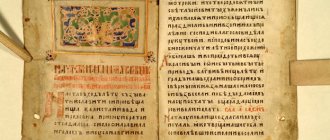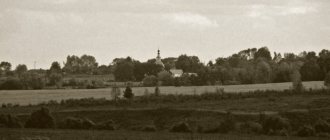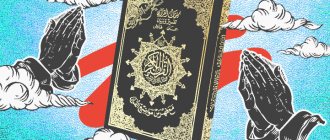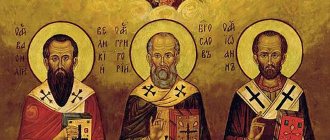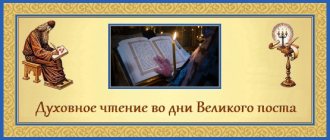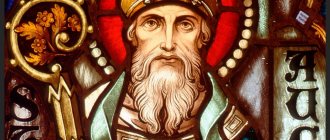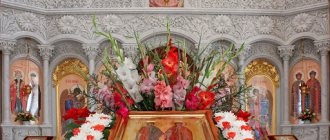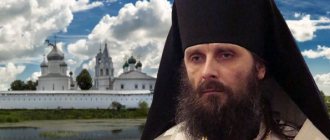Brief biography of Bede the Venerable
A monk from Saxony who managed to become not only a theologian and exegete, but also a historian and encyclopedist. The name Beda, with the emphasis on the first syllable, is of Latin origin. Bede was presumably born in 672/673 in northeastern England, Northumbria. On the grounds of the monastery in Moncton there is still a well named after the saint.
A monk from Saxony became a theologian, exegete and encyclopedist.
At the age of seven, Bede was sent to be raised at the Benedictine monastery of Vermount. Abbot Benedict Biscop taught the boy. Just a few years after the founding of the monastery in Jarrow, Bede moved into it and remained there until the end of his life. At the age of nineteen, the young man was ordained a deacon, and a year later he became a presbyter. The venerable one very rarely left the walls of the monastery. He was even asked to become rector, but he refused, fearing that his many responsibilities would distract him from his main occupation - scientific work.
Bede died in 735, on the bright feast of the Ascension of the Lord. Much later, already at the beginning of the 11th century, his relics were transferred to Durham Cathedral, where they are kept to this day.
The venerable one owns numerous works not only on theology and history, but also on the exact sciences, grammar, astronomy and even music.
Bede was ranked among the venerable saints already at the end of the twentieth century by Metropolitan Anthony.
Ecclesiastical history of the English people
Preface
Book One I. About the location of Britain and Hibernia and about their original inhabitants II. How Gaius Julius was the first Roman to arrive in Britain III. How Claudius, the second of the Romans to arrive in Britain, added the Orcadian islands to the Roman possessions, and how Vespasian, sent by him, also subjugated the island of Vecta IV to Rome. How Lucius, king of Britain, wrote to Pope Eleutheria, asking to make him a Christian V. How the North walled off one part of Britain from another VI. About the reign of Diocletian and how he persecuted Christians VII. Passion of Saint Alban and his companions, who at that time shed their blood for the Lord VIII. How, after the end of persecution, the Church in Britain lived in relative peace until the time of the Arian madness IX. How, during the reign of Gratian, Maximus became emperor in Britain and returned to Gaul with a large army X. How, during the reign of Arcadius, a Briton named Pelagius boldly rebelled against the mercy of God XI. How, during the reign of Honorius, Gratian and Constantine became tyrants in Britain and how soon the first of them was killed in Britain, and the second in Gaul XII. How the Britons, suffering from the raids of the Scots and Picts, asked for help from the Romans, who, having arrived again, blocked the entire island with a wall, but the new onslaught of the mentioned enemies entailed even worse disasters XIII. How, during the reign of Theodosius the Younger, Palladius was sent to the Scots, believers in Christ, and how the Britons vainly asked for help from the consul Aetius XIV. How the Britons, driven into despair by hunger, expelled the barbarians from their land, and how, following a bountiful harvest, troubles, plague and final destruction came to them. XV. How the Angles were called to Britain and at first expelled their enemies, but soon, having made peace with them, they turned their arms against their allies XVI. How the Britons first defeated the Angles under the leadership of a Roman named Ambrosius XVII. How Bishop Germanus sailed to Britain with Lupus and how he, by the power of God, subdued first the fury of the sea, and then the fury of the Pelagians XVIII. How he restored sight to the blind daughter of a tribune and then visited the place of execution of St. Alban, where he found his relics and placed next to them the relics of the blessed apostles and other martyrs of the 19th century. How he was struck by illness, extinguished burning buildings with prayer and was then healed of his illness thanks to the vision of XX. How those bishops brought heavenly help to the Britons in battle and then returned home XXI. How, after the re-emergence of the Pelagian plague, Herman returned to Britain with the North and first healed the lame youth, and then returned the people of God to the path of faith, condemning or converting the heretics XXII. How the Britons, freed for a time from external invasions, plunged into civil strife and committed many shameful acts XXIII. How Saint Pope Gregory, having sent Augustine with other monks to teach the English people, admonished them in writing not to weaken their efforts XXIV. How he wrote about them to the Bishop of Arelat XXV. How Augustine arrived in Britain and preached to the king of Kent on the island of Thanatos, and how he, having received permission, went to Kent to preach XXVI. How he lived and taught in Kent according to the customs of the ancient church and how he became a bishop in the royal capital of the 27th century. How, having become a bishop, he informed Pope Gregory about what he had done in Britain and received answers to the pressing questions he asked XXVIII. How Pope Gregory wrote to the Bishop of Arelat, asking him to help Augustine in the work of God XXIX. How the Pope sent Augustine a pallium with a letter and sent new ministers of the Word to him XXX. Copy of a letter sent to Abbot Mellitus on his way to Britain XXXI. How Augustine was encouraged in his letter not to be proud of the miracles he performed XXXII. How letters and gifts were sent to King Edilbert XXXIII. How Augustine restored the temple of the Savior and founded the monastery of the blessed Apostle Peter, and about Peter, its first abbot XXXIV. How Edelfrid, King of Northumbria, defeated the Scots in battle and drove them out of the land of the Angles Book Two I. On the Death of Blessed Pope Gregory II. How Augustine negotiated with the bishops of the Britons about church peace and performed a heavenly miracle in their presence, and about the punishment that befell them for disobeying him &42;&42;III. How he consecrated Mellitus and Justus as bishops and his death IV. How Lawrence and other bishops appealed to the Scots regarding the preservation of the unity of the Holy Church in the matter of calculating Easter and how Mellitus went to Rome V. How, after the death of Edilbert and Sabertus, their heirs restored the worship of idols and how, as a result, Mellitus and Justus left Britain VI. How, with the help of the Apostle Peter, Lawrence converted King Eadbald to Christ and how the king returned Mellitus and Justus VII. How Bishop Mellitus, when his city caught fire, subdued the fire with prayer VIII. How Pope Boniface sent a pallium and a letter to his successor Justus IX. About the reign of Edwin and how Paulinus came to him to preach the Gospel and taught his daughter Edwin and other people the sacraments of the faith of Christ X. How Pope Boniface sent a letter to the king, urging him to accept the faith XI. How he sent a letter to Edwin's wife, urging her to make every effort to save him XII. How Edwin was first persuaded to believe by a vision that appeared to him in exile XIII. How he held council with his entourage about accepting the faith and how their chief priest desecrated his shrines XIV. How King Edwin and his people converted and where Paulinus baptized them XV. How the faith of Christ was accepted by the province of the East Angles in the 16th century. How Paulinus preached in the province of Lindsay and about the reign of Edwin XVII. How Edwin received a letter of encouragement from Pope Honorius, who also sent Paulina the XVIII pallium. How Honorius, who succeeded Justa as bishop of the Doruvernian Church, received a pallium and a letter from Pope Honorius XIX. How Pope Honorius and subsequently Pope John sent letters to the Scots about Easter and the Pelagian heresy of the twentieth century. How, after the murder of Edwin, Paulin returned to Kent and became bishop of the Hrof church Book 3 I. How the heirs of King Edwin renounced the faith of their people and how the most Christian king Oswald restored the kingdom and faith II. How a certain man healed his sore hand, which was one of the many miracles wrought by the cross which this king erected before the battle with the barbarians III. How King Oswald asked the Scots for a bishop and Aidan was sent to him; and how the king established his episcopal residence on the island of Lindisfarne IV. When the Pictish people accepted the faith of Christ V. About the life of Bishop Aidan VI. About the faith and wondrous piety of King Oswald VII. How the kingdom of the West Saxons received the Word of God through the works of Birin and about his successors Agilbert and Leuther VIII. How Erconbert, king of Kent, ordered the idols to be destroyed; also about his daughter Ercongota and relative Edilberg, who became brides of Christ IX. How at the place where King Oswald was killed, miracles of healing took place and how first the traveler’s horse was cured, and then the paralyzed girl X. How the earth taken from that place extinguished the fire XI. How the relics of the king emitted heavenly light all night and how the possessed XII was healed by them. How at his grave a boy was cured of fever XIII. How in Hibernia his relics healed a man who was on the verge of death XIV. How, after the death of Paulinus, Itamar became bishop of Chrof in his place; and about the wondrous humility of King Oswin, who was mercilessly killed by Oswiu XV. How Bishop Aidan predicted a storm to the sailors and calmed it with the help of blessed oil XVI. How with his prayers he pacified the fire lit by the enemies to destroy the royal capital of the 17th century. How the support in the church, on which he leaned before his death, survived the fire when the whole church burned down; also about his spiritual life XVIII. About the life and death of the pious king Sigbert XIX. How Fursey built a monastery in the country of the East Angles; about his visions, his holiness and how after death his body remained incorruptible XX. How after the death of Honorius Deusdedit became a bishop and who was then the primate of the East Angles and in the Church of Chrof XXI. How the kingdom of the Middle Angles became Christian under King Paed XXII. How the East Saxons, who had long rejected the faith, were converted under King Sigbert by the preaching of Cedda XXIII. How Bishop Kedd, having received land from King Edilwald, built a monastery on it and consecrated it in the name of the Lord with fasting and prayer; also about his death XXIV. How the Kingdom of Mercia adopted the Christian faith after the murder of Penda and how Oswiu, in gratitude for the victory, granted the Lord possessions and lands for the construction of monasteries XXV. How a dispute arose about the time of Easter with those who arrived from Scottia XXVI. How Colman was defeated and returned home and Tuda became bishop in his place; about the position of the church under these learned men XXVII. How Egbert, a holy man from the English people, led a monastic life in Hibernia XXVIII. How, after the death of Tuda, Wilfrid was consecrated in Gaul, and Had by the West Saxons, and both of them became bishops in Northumbria XXIX. How Prester Wiegherd was sent from Britain to Rome for consecration as archbishop, and how a letter sent by the pope announced his death XXX. How the East Saxons returned to the worship of idols during the pestilence, but were cured of their errors by the labors of Bishop Jaruman Book Four I. How, after the death of Deusdedit, Wigherd was sent to Rome to be consecrated archbishop, and how after his death Theodore was consecrated and sent to Britain with Abbot Adrian. II. How Theodore gradually began to instruct the English churches in the study of Holy Scripture and in Catholic truth, and how Putta became primate of the Hrof church in place of Damian. III. As already mentioned, Had was made bishop of the Mercian province; about his life, death and burial IV. How Bishop Colman, having left Britain, founded two monasteries in Scotia - one for the Scots, the other for the Angles, whom he brought with him. V. About the death of kings Oswiu and Egbert and about the council at Herutford, which was headed by Archbishop Theodore VI. How, after the removal of Winfrid, Sexwulf took his place, and Erkenwold became Bishop of the East Saxons VII. How heavenly light shone over the place where the nuns of the Berikinen Monastery VIII were buried. How a boy dying in this monastery called out to the nun who followed him, and how another nun, before her death, saw the coming light IX. About the heavenly signs that announced the death of the abbess of the monastery X. How a blind woman, praying in the monastery cemetery XI, regained her sight. As king of this province, Sebbi ended his days as a monk XII. How Hadda became bishop of the West Saxons instead of Leuther; how Kvihelm succeeded Putta in the bishopric of Hrof, and Kvihelm was succeeded by Gethmund; who was then bishop in Northumbria XIII. How Bishop Wilfrid converted the kingdom of the South Saxons to Christ XIV XV XVI (XIV). How Christians settled on the island of Vekta and how two young men were killed there immediately after baptism XVII (XV). About the council under the leadership of Theodore, held on a field called Hatfeld XVIII (XVI). About the regent of the apostolic choir John, who arrived to teach in Britain in the 19th (XVII) years. How Queen Edelfrida kept her virginity and how her body remained incorrupt in the grave XX (XVIII). Hymn to her XXI (XIX). How Archbishop Theodore made peace between Kings Egfrid and Edilred XXII (XX). How the shackles were removed from a certain prisoner after Mass XXIII (XXI) was celebrated for him. About the life and death of Abbess Hilda XXIV (XXII). How in her monastery there was a brother endowed with the divine gift of versification XXV (XXIII). How a certain man of God saw a vision of the Koludan monastery, engulfed in fire XXVI (XXIV). About the death of kings Egfrid and Hlother XXVII (XXV). How Cuthbert, a man of God, became a bishop, and how before that he lived and taught as a monk XXVIII (XXVI). How, being a hermit, he drew a spring from dry land and how he reaped the harvest of grain that he had sown at the wrong time XXIX (XXVII). How this bishop predicted the hermit Herebert's imminent death XXX (XXVIII). How his body was found incorrupt eleven years after burial and how his heir soon ended his life in the office of bishop XXXI (XXIX). How a certain man was healed of paralysis at his grave XXXII (XXX). How another husband was later healed by his relics from an eye disease Book Five I. How Edilwald, Cuthbert's heir in the labors of the hermit's life, calmed the storm with his prayers when his brothers struggled with the waves II. How Bishop John healed a deaf man with his blessing. III. How he healed a sick girl with his prayers. IV. How he healed the sick wife of Comite V with holy water. How he brought the servant of Comite VI back to life with prayer. How with his prayers and blessing he saved from death a cleric who suffered from the fall of VII. How Cadwalla, king of the West Saxons, came to Rome for baptism, and how his heir Ine also visited the tombs of the blessed apostles VIII. How, after the death of Theodore, Bertwold became archbishop and how, among many initiates, he appointed the most learned Tobias as bishop of the church of Chrof IX. How a holy man named Egbert wanted to go preaching to Germany, but was not allowed there; and how Victbert got there, but did not succeed and returned to Hibernia, from where he came X. How Willibrord preached in Frisia and converted many to Christ and how his companions Hewald became martyrs XI. How the Venerable Swidbert and Willibrord were consecrated bishops of Frisia, the one in Britain and the other in Rome XII. How a certain man in Northumbria rose from the dead and told of many things he had seen, both frightening and joyful XIII. How, on the contrary, to another husband, standing on the threshold of death, the demons showed a book where his sins were recorded XIV. How another husband, on the eve of death, saw the place of his future hellish torment XV. How most of the Scots churches accepted Catholic Easter at the insistence of Adamnan and how the latter wrote a book about the holy places of the XVI. What he wrote in this book about the places of the birth of the Lord, His passion and His resurrection ХVII. What he wrote about the place of the Ascension of the Lord and about the tombs of the XVIII patriarchs. How the South Saxons received Edbert and Eollan as bishops, and the West Saxons Daniel and Aldhelm, and about the writings of the mentioned Aldhelm XIX. How Cenred, king of the Mercians, and Offa, king of the East Saxons, ended their lives in Rome as a monk and about the life and death of Bishop Wilfrid XX. How Albinus succeeded Abbot Hadrian, and Bishop Wilfrid XXI of Akka. How Abbot Ceolfrid sent temple builders to the kingdom of the Picts and sent with them a letter about the Catholic Easter and the XXII tonsure. How the monks of Oia and the monasteries subordinate to them began to celebrate Catholic Easter according to the teachings of Egbert XXIII. The present state of the English people and all of Britain XXIV. Chronological table of contents of the entire work; also about its author
Preface
To the most glorious king Ceolwulf1-Bede, servant of Christ and priest.
According to your wishes, king, I have already sent you for your reading and approval the ecclesiastical history of the English people, which I recently completed2; Now, with the greatest pleasure, I am sending it again for copying and further study3. I sincerely rejoice at the care with which you not only delve into the words of Holy Scripture with a diligent ear, but also strive to learn about what was created and said in the past, especially by famous men of our people. After all, if a story tells about the good deeds of good people, then its thoughtful listener is encouraged to imitate the good; if she speaks about the evil deeds of the wicked, then the religious and pious listener or reader learns to beware of what is evil and vice, and to follow what is recognized as good and pleasing to God. Realizing this with your characteristic insight and caring for the general spiritual good, you wished that the above-mentioned history should be better known to both you and the people over whom Divine Providence placed you. Now, in order to dispel the doubts of you and those who will listen or read this story, I will take care to briefly indicate the sources from which I drew information4.
First of all, I must name the mentor and inspirer of this modest work, the most reverend Abbot Albinus, a most learned man, who was taught in the Church of Kent by Archbishop Theodore and Abbot Adrian, also most venerable and learned men. He carefully collected everything that was preserved in records or in ancient tradition about the deeds of the disciples of Pope Gregory in the province of Kent7 and in neighboring lands. All this, preserved by his marvelous memory, he conveyed to me through the priest of the London8 church of Nothelm9 in written messages or in the retelling of the mentioned Nothelm. After this, Nothelme went to Rome and received permission from the present Pope Gregory10 to study the archives of the holy Roman Church, where he found letters from the blessed Pope Gregory and other pontiffs, which, on the advice of the Most Reverend Albinus, he sent to us for inclusion in our history.11
I learned about the events that happened from the beginning of this work to the time when the English people acquired the faith of Christ from all reliable sources, mainly from the books of previous authors12. I learned about what happened from then until now - about the actions in the Kent church of the disciples of the blessed Pope Gregory and their heirs and under which kings this happened - from the mentioned Abbot Albin in the transmission of Nothelm. They also added to my knowledge of which bishops brought the good of the promise to the East and West Saxons, to the East Angles and Northumbrians,13 and during the reigns of which kings this happened. It should be said that only Albin’s encouragement prompted me to create this work14. The living and now most reverend bishop of the West Saxons, Daniel15, in a written message, gave me some information about the history of the church in his province and in the neighboring province of the South Saxons16, as well as on the island of Vekta17. I also learned from the brethren of the monastery called Lestingey18 how, through the efforts of its founders, the holy fathers Cedda and Had19, the faith of Christ came to the province of Mercia, where it was not known before, and returned to the province of the East Saxons, where it was forgotten, and also about that how these holy fathers lived and died. Next I traced the history of the church in the province of the East Angles, partly from ancient writings and traditions, partly from the words of the most reverend Abbot Esi20. I learned about the works of the faith of Christ and about the change of bishops in the province of Lindsay21 from the letters of the Most Reverend Primate Cynebert22 or from the lips of other reliable people. In describing the events in different parts of the Northumbrian province from the time of her acquisition of the faith of Christ to the present time, I did not rely on anything other than the reliable testimony of many eyewitnesses who knew exactly or recalled what I myself did not know. In this regard, it should be said that everything that I wrote about the Holy Father and Primate Cuthbert23 in this work and in a special work dedicated to his deeds, I took in part from his life, written by the brethren of the Lindisfarne Church,24 taking on faith the stories that are contained there. In part, I took care to supplement these stories with what I myself learned from reliable witnesses. I humbly ask readers not to blame me for any errors against the truth that may occur in my work, for in accordance with the true law of history25 I simply wrote down those of the collected information that I considered useful for the education of posterity.
I also humbly ask everyone who listens or reads this history of our people, that they do not forget to pray for the highest mercy for my many weaknesses, mental and physical, and would give me tribute in all lands. And because I diligently collected information about those events in different provinces and places that are worthy of the memory and attention of their inhabitants, may these provinces reward me with the harvest of their pious intercession.
End of the preface. The beginning of the list of chapters.
Miracles and help of the saint
The life of the saint dates back to the early Christian period, so evidence of miracles during his lifetime has not been preserved. Perhaps somewhere in the West the lost information has been preserved, but it has not yet reached us. However, there is chronicle evidence of miraculous healing thanks to the relics of the saint. Another miracle is the condescension of an angel on the day of the monk’s death, during which he bestowed the title “Venerable” on Bede.
The saint's entire life was devoted to science. He also translated the Old and New Testaments to make them accessible to future generations. That is why it is considered logical to seek help from the Venerable One in the search for knowledge, in science and study.
An interesting fact is that the Western religious tradition differs from the Russian one in that it does not refer to one specific saint in any matter.
Tombstone of a saint in Durham Cathedral
Links
- The Venerable Trouble // Encyclopedic Dictionary of Brockhaus and Efron: in 86 volumes (82 volumes and 4 additional). - St. Petersburg, 1890-1907.
- Trouble Hon.
Other Albertus Magnus · Alfonso Liguori · Anselm of Canterbury · Anthony of Padua · Bede the Venerable · Bernard of Clairvaux · Saint Bonaventure · Cyril of Alexandria · Cyril of Jerusalem · Ephraim the Syrian · Francis de Sales · Hilary of Pictavia · Isidore of Seville · John of Avila · John of Damascus · John of the Cross · Lawrence of Brindisia · Leo the Great · Peter Canisius · Peter Chrysologos · Peter Damiani · Roberto Bellarmine · Thomas Aquinas · Grigor Narekatsi Women Teresa of Avila · Catherine of Siena · Teresa of Lisieux · Hildegard of Bingen
Sacred Works
The saint penned about 40 books on various branches of knowledge. His works were kept in all major European libraries. His most famous works are:
- "Ecclesiastical History of the Angles";
- “About Spelling”;
- “On metrical art”;
- "Book of Epigrams".
Numerous works contributed to the spread of the fame of the Venerable One from Britain throughout Europe.
It was Bede, when translating the Holy Scriptures, who announced the names of the Magi who were the first to visit the baby Jesus. It is also interesting that the saint is one of the few immortalized in Dante's Divine Comedy, along with Thomas Aquinas.
Title page of the Basel collected works (1563)
Miniature from the manuscript of the Life of St. Cuthbert by Bede
Miniature from a 12th century manuscript of the Life of St. Cuthbert by Bede
Literature
- Nenarokova M.R.
Venerable Bede - rhetorician, hagiographer, preacher. - M.: IMLI RAS, 2003. - 272 p. - Petrova M. S. Rhetorical and grammatical works of the Venerable Bede in the context of linguistic knowledge of Late Antiquity and the Early Middle Ages. // Intellectual traditions in the past and present (research and translations) / Compilation and general editing by M. S. Petrova. - M.: IVI RAS, 2012. - P. 36-63. ISBN 978-5-94067-358-3.
- Brown, George Hardin (1987). Bede, the Venerable. Boston: Twayne. ISBN 0-8057-6940-4.
- Gehle, "De Bedae Venerabilis vita et scriptis" (Leiden, 1838).
- Wrights, "Biographia britannica litteraria" (vol. 1, London, 1843).
- K. Werner, “Beda der Ehrwürdige” (Vienna, 1875).
The role of the saint in Christianity
Venerable Bede is venerated on May 27, the day of the saint’s death. Indeed, according to the testimonies of his disciples, the monk departed into another world with prayer on his lips, in happiness and peace. On this day, a solemn liturgy is served in Jarrow and they talk about the life, service and talent of the monk.
It is difficult to overestimate the role of the person who translated and interpreted the Bible, trying to make the text accessible and understandable to everyone. Also from the pen of the monk came many scientific works, which facilitated further research and filled in some gaps in history.
Undoubtedly, the Venerable Bede is a unique person, whose encyclopedic knowledge contributed to breakthroughs in many branches of science in the Middle Ages. And this despite the fact that the monk practically did not leave the walls of the monastery, managing to serve not only God, but also people.
If you find an error, please select a piece of text and press Ctrl+Enter.
Pseudepigrapha
Bede has been credited with writings on different topics at different times[6]. Among them are two small musical treatises published by Min in 90 (col. 909 ss.) under the titles, respectively, Musica theorica
(inc.
Notandum quod, cum omnis ars in ratione contineatur
) and
Musica quadrata seu mensurata
(inc.
Quoniam circa artem musicam
). The first of them is another (undated) scholia to Boethius’s “Principles of Music”[7], the second is Master Lambert’s “Treatise on Music” (13th century)[8].
